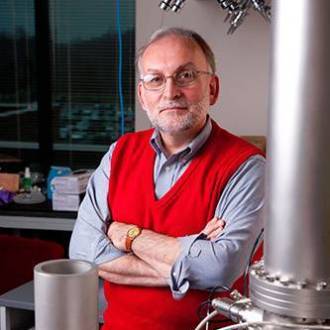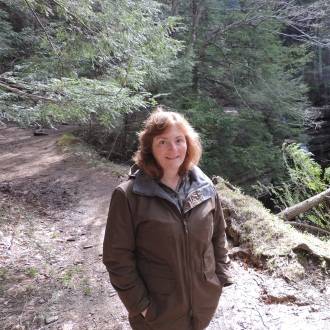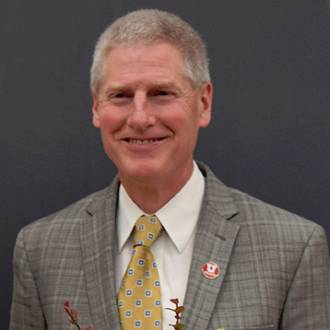
Professor Joseph A. Gardella, Jr. received his Ph.D. in Analytical Chemistry at the University of Pittsburgh and completed postdoctoral research in Physical Chemistry at the University of Utah, working with Ted Eyring in 1982. He then joined the faculty at University at Buffalo, State University of New York, where he is now a Distinguished Professor and the John & Frances Larkin Professor of Chemistry. Joe’s research interests are in quantitative analysis and surface chemistry, broadly applied to the study of environmental effects on polymer surfaces and tissue engineering with synthetic biomaterials. He is also director of the Interdisciplinary Science and Engineering Partnership (ISEP), which brings together the University of Buffalo, 21 public schools, the Buffalo Museum of Science, and Buffalo State College to increase hands-on learning in science classes.

Diane B. Parry obtained her Ph.D. in Physical and Analytical Chemistry at the University of Utah with Professor Joel Harris in 1989, followed by postdoctoral research with Mike Philpott at IBM’s Almaden Research Center in San Jose, CA. She has worked at Procter & Gamble for 26 years, leading many disciplines within Research & Development, including supply chain innovation, process design, consumer understanding, and formula design. Diane is currently a Research & Development Associate Director; her department includes chemists, physicists, and engineers and stretches across six countries. Diane is also the President of the Society for Applied Spectroscopy. She has been involved in FACSS and SciX for more than ten years, including as the Governing Board Chair in 2006, and started organizing sessions on “Analytical Chemists Easing World Poverty” in 2010.

Don L. Reese, MD received his B.S. in Chemistry from the University of Utah in 1973. He then attended medical school at the University of Utah, earning his Doctor of Medicine degree in 1977. He completed a dermatology residency at the University of Minnesota in 1981. In 1983, Don started his own private practice in dermatology, working in the field until his recent retirement. Don and his wife Rebecca have been champions of undergraduate teaching and research at the U. They have generously endowed a scholarship in science teaching with the College of Science and a chemistry scholarship through the Ragsdale Fund. Their contribution to the Thatcher Building established the Department’s advanced undergraduate laboratories. Don and Rebecca are also founding members of the Curie Club.
Kirk M. Ririe is a visionary scientist and inventor with several patents to his name. He currently serves as CEO of BioFire Defense, which delivers a fully integrated suite of biological agent identification products and life science systems to the biodefense and first responder community. Among his inventions, he built a prototype to shorten the processing time of a cutting-edge DNA analysis technique called PCR from hours to minutes. This prototype, and assistance from his alma mater, the University of Utah, spurred his founding of BioFire Diagnostics, Inc. and the invention of the LightCycler. His latest invention, FilmArray System and Respiratory Panel was approved by the FDA in 2011 to quickly test dozens of organisms simultaneously. Ririe is the recipient of numerous awards, including Entrepreneur of the Year from Ernst & Young in 2004, the Franklin Jefferson Award in Science and Technology Innovation in 1999, and the Utah Technology Council’s Hall of Fame in 2014.
Rodrigo Noriega joined the faculty in 2016. He earned his Ph.D. in Applied Physics from Stanford University, working with Alberto Salleo in the Materials Science and Engineering department on the connection between structural disorder and charge transport in organic semiconductors, culminating in a Nature Materials article that was highlighted in Nature Materials and Science. Rodrigo’s postdoctoral work with Naomi Ginsberg at UC-Berkeley focused on the effects of the local environment on the photophysical properties of biomimetic light harvesters and new organic light-emitting diode materials using ultrafast spectroscopy and single molecule measurements.
In 2016, the department was home to four prominent chemistry publications: The Journal of the American Chemical Society, led by Peter Stang, The Journal of Organic Chemistry, led by Dale Poulter, Accounts of Chemical Research, led by Cindy Burrows, and the Journal of the Electrochemical Society, with Shelley Minteer as Technical Editor. Cindy Burrows remains the Editor-In-Chief of Accounts of Chemical Research to this day, and Shelley Minteer is the Editor-in-Chief of the ACS Au suite of journals.
On March 23rd, the Curie Club hosted a lunch for all the women faculty members in the College of Science to meet Carol Gross, a Professor at UCSF and member of the National Academy who studies functional and regulatory networks in bacteria. Her other passion is increasing diversity in STEM both by mentoring students/faculty and developing programs to increase student diversity. Professor Gross gave a Hugo Rossi Lecture entitled “Participation of Women
in Science: Problems and Solutions” during her visit to the U. There is abundant evidence that women are underrepresented in STEM disciplines. In this talk, Professor Gross discussed some of the root causes, documented disparities, and presented strategies to enhance the success of women graduate students and faculty.
On April 12th, the Department of Chemistry held the inaugural Robert W. Parry Lectureship in Inorganic Chemistry. This annual lecture honors Distinguished Professor Bob Parry, one of our most notable former faculty members. The lecture was delivered by Professor Harry Gray, a world-class inorganic chemist from Caltech, a friend of Bob Parry’s, and a donor to the fund. As Bob’s friend, he had some wonderful stories to share with those in attendance. Bob’s wife, Marjorie Parry, and one of their granddaughters also attended, making the first Parry Lecture a truly special event.
Kirk M. Ririe (BS ’05) received an honorary Doctor of Science degree at the University’s commencement ceremony on May 5th, 2016. This is the highest honor given by the U. Ririe is a visionary scientist and inventor with numerous patents to his name. He currently serves as CEO of BioFire Defense, which delivers a fully integrated suite of biological agent identification products and life science systems to the biodefense and first responder community. Among his inventions, he built the prototype to shorten the processing time of the Nobel prize-winning DNA
analysis technique called PCR from hours to minutes. This prototype, and assistance from his alma mater, the University of Utah, spurred his founding of BioFire Diagnostics, Inc. and the invention of the LightCycler. His latest invention, FilmArray System and Respiratory Panel was approved by the FDA in 2011 to quickly test dozens of organisms simultaneously. Ririe is the recipient of numerous awards, including recognition as a Chemistry Distinguished Alumnus in 2015, Entrepreneur of the Year from Ernst & Young in 2004, and the Franklin Jefferson Award in Science and Technology Innovation in 1999.
Professor Emeritus Ted Eyring is a prominent figure in the memories of chemistry alumni. Ted has been a pillar of the department for over 50 years. To celebrate Ted’s recent retirement and the consideration he always gave to his students and colleagues, the Department is raising funds to endow the Edward M. Eyring Lectureship in Chemistry. The Eyring Lectureship will invite eminent physical chemists to present their latest research to our students and faculty at an annual lecture.
John Heemstra was selected for a 2016 U of U Early Career Teaching Award. Dr. Heemstra (now at Washington University) taught general, organic, and biochemistry with huge success. His past students enjoyed his teaching so much that they reported wanting to take all of the chemistry courses he was scheduled to teach. Heemstra earned his Ph.D. in chemistry at the University of Illinois at Urbana-Champaign in 2007 and was a postdoctoral fellow at Harvard Medical School. He joined the teaching faculty at the University of Utah in 2012. In his short time with the Department, he won numerous teaching awards, nominated by both faculty and students.
Three students from the Department of Chemistry won 2016 pre-doctoral fellowships from the National Science Foundation Graduate Research Fellowship Program:
- Sophie Bertram, who graduated in May 2014, was awarded an NSF Graduate Research Fellowship to pursue her Ph.D. at MIT.
- Sophia Robinson (Ph.D. 2020), then a member of Matt Sigman’s group, working on a collaborative project with Shelley Minteer.
- Julieann Selden, then a member of Ilya Zharov’s group, working on a Materials Research Science & Engineering-related project.
The Cheves T. Walling Graduate Research Award goes to the writer of the year’s top Ph.D. dissertation. This year, the award was given to two researchers who shared the top spot:
- Jay Kitt, “Raman Microscopy Studies of Liquid/Solid Interfaces Within Individual Porous Silica Particles”
- David Baumann, ““Synthesis of Diacyl Glycerol Lactone-Based Bryostatin Analogs: Progress Towards a Simplified Binding Domain that Retains the Biological Properties of the Natural Product”
George and Camilla Smith, generous long-time supporters of the University of Utah, funded the Henry Eyring Lectureship in Chemistry and the Bryant A. Miner Lectureship in Chemistry in 2016.
These endowments memorialize two important chemists in the Department’s history: Bryant A. Miner, Camilla Smith’s brother, who earned his Ph.D. in chemistry at the U in 1965 and taught countless chemists in his 43 years at Weber State University, and Henry Eyring, Camilla and Bryant’s uncle, who established the U’s Graduate School and was one of our nation’s most renowned chemists.
These lectures are unique because of Henry Eyring and Bryant Miner’s mentor-mentee relationship. Eyring was the thesis advisor for his nephew’s doctoral degree. The inaugural lectures were held in the spring of 2017, featuring two outstanding chemists with the same mentor-mentee relationship (Nobel Laureate Prof. Robert Grubbs and his former graduate student Prof. Melanie Sanford), along with the dedication of the Henry Eyring and Bryant A. Miner Chemistry Lecture Theater.
The Curie Club launched a new event series reaching out to undergraduate and graduate students across STEM fields. Each month, two successful women in science or engineering careers in academia or industry give advice, offer mentorship, and talk about their career paths to a large group of female students.
In the fall of 2016, the Department of Chemistry started a new undergraduate mentoring program to match incoming chemistry students with advanced chemistry students to serve as mentors. Research has shown that graduation and retention rates increase by creating a sense of belonging when students first arrive at their university. In the Department of Chemistry, peer mentoring groups are established in the chemistry undergraduate seminar course to ensure that students develop a community within the department early in their academic career at the U. At the end of the semester, students go on a campus-wide scavenger hunt to find all the campus resources available to them during their time at the U.
The Master of Science for Secondary School Teachers (MSSST) degree program in the College of Science provides a unique opportunity for practicing secondary school teachers to earn an MS degree in science teaching with a focus on developing science content knowledge rather than pedagogy. Chemistry professor Tom Richmond directs the program.
In the past two years, more than forty degrees have been awarded in this cohort-based program, culminating in an authentic hands-on research experience. Even experienced teachers find they benefit from a return to the college classroom. However, their research lab placements alongside graduate students and postdoctoral researchers allow teachers to expose the process of research and contribute to the discovery of new knowledge. Teachers ultimately take the excitement of research back to their classrooms, enhancing public education in Utah.
In 2016, the Department of Chemistry was recognized as one of the top departments for female faculty in C&EN. Of the top 50 schools in terms of chemical R&D spending, Utah came in 5th for the number of women and 6th for the percentage of women, at 26% – well above the average of 19%.
Alumni News:
Joe Stewart (MS ‘91)
After graduation, Joe Stewart worked for three years at an environmental testing laboratory using GC/MS to analyze soil and water extracts and industrial hygiene-related sorbent tubes and air samples. Then he decided to start his own company, OnSite Analytical Services. He built a small laboratory in West Valley City and did analytical work for the stack testing, plume mapping, and petroleum refining industries. This was fun and varied work. One memorable job was an investigation of unwanted explosions in a specific process, located about 500 yards downrange of another explosion test site constantly bombarding him with shockwaves on the job. In 1999, Joe closed his business and began work for Kennecott Utah Copper, moving from process chemist to Senior Project Engineer. He worked on troubleshooting water treatment systems, performing risk analysis for proposed capital projects, managing the site-wide contaminant transport model, and modeling water mixing strategies. In 2009, he became a research engineer at the Utah Water Research Laboratory, working various LC/MS and GC/MS systems and developing compound-specific analytical methods to meet research needs. He will also complete a graduate degree in Technical Writing this December.
Courtney Gwinn (BS ‘12)
Courtney Gwinn is currently an MD Candidate at the University of Washington School of Medicine in the class of 2016. She is about to begin her residency in Internal Medicine at the University of Washington.
Richard Nkansah (MS ‘12)
Richard Nkansah lives in Bend, Oregon, with his wife, Zola, where he works as a chemist for a pharmaceutical company. His work is filled with several inteexcitingblem statements and opportunities to make better medicines through science and engineering. Zola works as an admissions specialist and recruiter for the Oregon State University, Cascades campus in Bend.
Sabah Ul-Hasan (BS ‘12)
Sabah Ul-Hasan is currently a Ph.D. Eugene Cota-Robles Fellow in Quantitative and Systems Biology at the University of California, Merced. She is also part of BIOTA, a science documentary series that merges art and science to spotlight symbiotic relationships and strives to reach audiences traditionally underrepresented in science. The first episode of the documentary web series premiered at The Leonardo in Salt Lake City on April 28, 2016. Find the show online athttp://biotatvorg.tumblr.com/.
Miles Roberts (BS ‘14)
Miles Roberts graduated with his BS in Chemistry in 2014. He moved to the Big Island of Hawaii the summer after graduation and began attending the Daniel K. Inouye College of Pharmacy in Hilo. Miles hopes to return to Utah for a portion of his fourth-year rotations. He will receive his Doctorate in Pharmacy in May 2018. He is proud to have graduated from the U and often thinks about the friendships made and counsel received as an undergrad. Miles is incredibly grateful for Professors Jon Rainier and Holly Sebahar, excellent examples of outstanding teachers.
